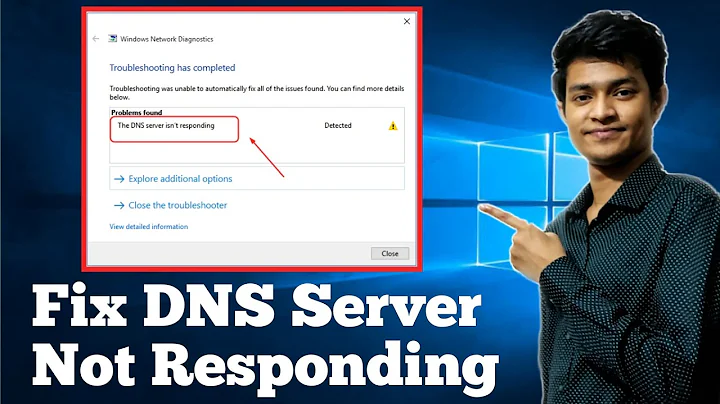How to find my DNS Server address in Windows 7
Solution 1
If you know your public IP address simply enter in a command prompt window:
nslookup <your public IP>
You can also specify the name server to check against by appending it to the above command.
You can get your current IP address from sites like http://whatismyip.com
Solution 2
You want to open "Run" then type
cmd.exe
In the command prompt enter this command
C:\>ipconfig /all | findstr /R "DNS\ Servers"
The output should look something like:

Solution 3
Personally, I prefer this approach:
echo | nslookup | findstr "Default\ Server"
It will print the name of your default DNS server in the shell
Solution 4
echo exit | nslookup
This will show the primary DNS server domain name and IP address.
Default Server: google-public-dns-a.google.com
Address: 8.8.8.8
>
Thanks to @OliverSalzburg's answer.
Solution 5
The following powershell command outputs the DNS information in a structured format:
powershell Get-DnsClientServerAddress
Example output:
InterfaceAlias Interface Address ServerAddresses
Index Family
-------------- --------- ------- ---------------
vEthernet (Default Switch) 21 IPv4 {}
vEthernet (Default Switch) 21 IPv6 {fec0:0:0:ffff::1, fec0:0:0:ffff::2, fec0:0:0:ffff::3}
Wi-Fi 17 IPv4 {10.0.0.1}
Wi-Fi 17 IPv6 {2001:123:456:789::1, 2001:123:456:789::2}
Related videos on Youtube
rakib
Updated on September 18, 2022Comments
-
rakib over 1 year
What is the easiest way to know my current DNS server's IP address or domain name? I am trying to troubleshoot my broadband Internet connection under Windows 7.
-
vesquam over 11 yearsDo you mean Ip address? Or are you actual trying to find which name server you're connection is using?
-
-
rakib over 11 yearsthats seems fine .. but there was some conflict :( pls see the photo i.stack.imgur.com/Ua6cT.png any solution? Thanks
-
 Canadian Luke over 11 years@rakib Means there is no public DNS name for you, or your ISP doesn't give one
Canadian Luke over 11 years@rakib Means there is no public DNS name for you, or your ISP doesn't give one -
 Canadian Luke over 11 yearsThat shows the DNS server, not the DNS name
Canadian Luke over 11 yearsThat shows the DNS server, not the DNS name -
mrchampe over 11 years@rakib, please try running "ipconfig /all" as that will give you more details on the problem. You are essentially troubleshooting your internet connection, yes?
-
mrchampe over 11 yearsSince he is troubleshooting his internet it seems he wants to verify he is connected to the ISP DNS server. It is unlikely he even has a DNS address, which is shown in the screenshot he shared
-
Oliver Salzburg over 11 yearsYou can just
nslookupanything. It doesn't have to be your own IP address. If you don't provide any parameters, the interactive shell will start and will display the active nameserver right at the top. -
 Mike S over 8 yearsThis should be the accepted answer, since it directly answers the user's question: "my current DNS server address..." However, on my Windows box the DNS Servers come as a group and not all of them are prefixed with the string. ipconfig /all works, though, if you eyeball it.
Mike S over 8 yearsThis should be the accepted answer, since it directly answers the user's question: "my current DNS server address..." However, on my Windows box the DNS Servers come as a group and not all of them are prefixed with the string. ipconfig /all works, though, if you eyeball it. -
 merosss about 6 yearsactually a combination of the two answers gives the best result:
merosss about 6 yearsactually a combination of the two answers gives the best result:echo exit | nslookup | findstr ":". Just using yours in PS prompts "Supply values for the following parameters: InputObject[0]:", while the other one prints unnecessary lines. -
jan-glx over 3 yearsThe order printed is not necessarily the same as the order used.
-
Tode about 3 yearsPlease do not simply post a command without an explanation about what the command does and how to interpret the output.
-
Shivanshu Goyal about 3 yearsShould it have been a comment then?
-
Tode about 3 yearsNo: Your solution is valid... just flesh out your answer a bit with the result of the command and why you think this answers the question...
-
Shivanshu Goyal about 3 years@TorstenLink I've made the suggested changes
-
Tode about 3 yearsYes, that is what I thought... +1 from me.
-
 Timo almost 3 yearsThis does not work in
Timo almost 3 yearsThis does not work inPSto get a quick result, see Bob's answer for PS.




